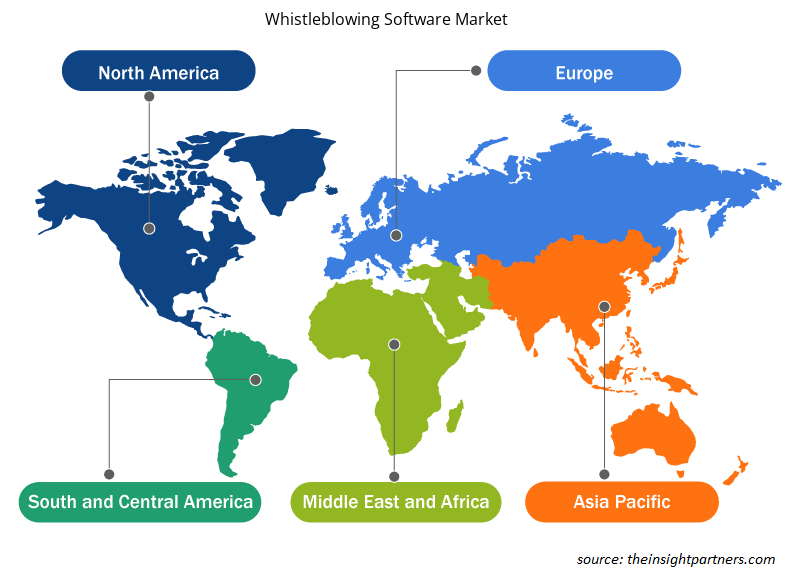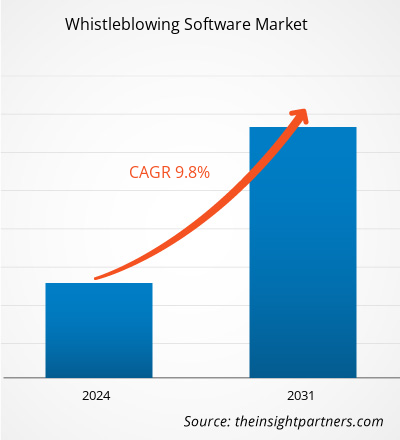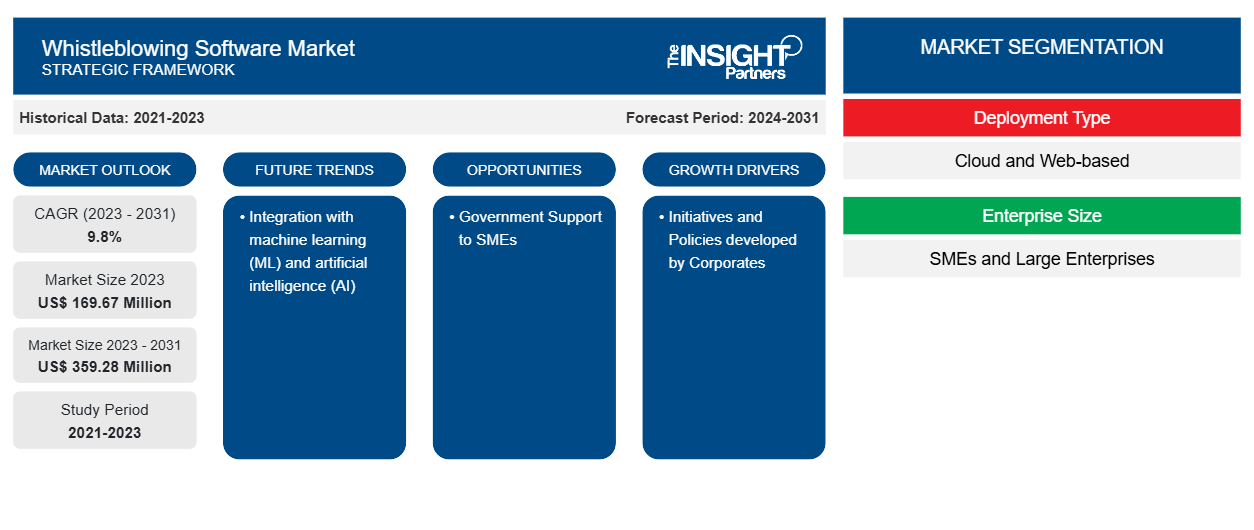Se prevé que el tamaño del mercado de software de denuncia de irregularidades alcance los 359,28 millones de dólares en 2031, frente a los 169,67 millones de dólares en 2023. Se espera que el mercado registre una CAGR del 9,8 % entre 2023 y 2031. Es probable que el aumento de la popularidad del software de denuncia de irregularidades multilingüe y la necesidad de garantizar la seguridad de los empleados sigan siendo tendencias clave del mercado.
Análisis del mercado de software de denuncia de irregularidades
El aumento de la conducta deshonesta y poco ética dentro de las organizaciones acelerará la adopción de software. Una mayor necesidad de proteger la seguridad de los empleados debido al aumento de los delitos cibernéticos dentro de la empresa alimenta la demanda de software. Además, el software proporciona a los ejecutivos y a las juntas directivas informes y conocimientos. Proporciona mitigación de riesgos operativos, toma de decisiones informada y mitigación legal. Se prevé que estos atributos impulsarán la expansión del mercado.
Descripción general del mercado de software de denuncia de irregularidades
Las organizaciones pueden identificar problemas en el lugar de trabajo, como fraude, acoso, robo, malversación de fondos, corrupción y más, mediante el uso de software de denuncia de irregularidades, un tipo de solución de gestión de problemas que ofrece a los empleados opciones de denuncia anónima. Las soluciones de denuncia de irregularidades, también conocidas como líneas directas, líneas de ayuda o soluciones de gestión de casos, tienen como objetivo abordar problemas como fraude, mala conducta y comportamiento poco ético que entran en conflicto con los principios o políticas de una organización. La comunicación bidireccional anónima se puede facilitar a través de plataformas en línea o móviles que ofrecen estas soluciones de gestión de problemas. También ofrecen herramientas de análisis para identificar áreas en las que la mala conducta es común, así como herramientas para que las organizaciones reciban informes y examinen las acusaciones.
Personalice este informe según sus necesidades
Obtendrá personalización en cualquier informe, sin cargo, incluidas partes de este informe o análisis a nivel de país, paquete de datos de Excel, así como también grandes ofertas y descuentos para empresas emergentes y universidades.
-
Obtenga las principales tendencias clave del mercado de este informe.Esta muestra GRATUITA incluirá análisis de datos, desde tendencias del mercado hasta estimaciones y pronósticos.
Factores impulsores y oportunidades del mercado del software de denuncia de irregularidades
Protección de denunciantes para combatir la corrupción en beneficio del mercado
Según la Organización para la Cooperación y el Desarrollo Económicos (OCDE), la protección de los denunciantes se define como “proteger y/o proporcionar un recurso contra cualquier acción de represalia a las personas que trabajan en el sector privado o público que denuncien con motivos razonables actos sospechosos de soborno a funcionarios públicos extranjeros en transacciones comerciales internacionales y delitos relacionados en un contexto laboral. Por lo tanto, la protección de los denunciantes es crucial para detectar la mala conducta, fomentar la transparencia y promover la integridad, lo que a su vez impulsa la demanda de software de denuncia de irregularidades.
Apoyo gubernamental a las PYMES: una oportunidad en el mercado del software de denuncia de irregularidades
Las PYME son importantes contribuyentes al crecimiento económico, ya que representan la mayoría de las empresas en todo el mundo, alrededor del 90%. Sin embargo, debido a las limitaciones financieras, el crecimiento de las PYME se desacelera. Por lo tanto, el sector gubernamental y las organizaciones apoyan constantemente a las PYME para expandir sus negocios, lo que contribuye aún más al crecimiento económico de cualquier país. A medida que las empresas se vuelven digitales, la adopción de software para proteger los datos de la empresa se ha convertido en el aspecto fundamental de cualquier organización. El apoyo gubernamental para proporcionar ayuda financiera a las PYME aumenta su capacidad para aprovechar soluciones avanzadas para proteger la información crítica de su empresa. Por lo tanto, el apoyo gubernamental a las PYME contribuye a enormes oportunidades para el crecimiento del mercado de denuncia de irregularidades. A continuación, se mencionan algunas de las ayudas gubernamentales:
- En Europa, una red de centros europeos de innovación digital o la red Enterprise Europe Network ofrece ayuda a las pymes para que adopten herramientas digitales de forma segura. Ofrecen soluciones como la sensibilización, la evaluación de la madurez digital, el acceso a financiación, la tutoría y la facilitación de la experimentación con herramientas digitales.
- Según la encuesta de Capterra India de agosto de 2023, alrededor del 40 % de los encuestados recibió financiación gubernamental para la digitalización al menos una vez, y alrededor del 20 % la recibió varias veces. Además, las iniciativas del gobierno indio, como el programa RAMP, el Plan Innovador para las PYME, el plan ASPIRE y otras, se centran en impulsar la digitalización de las PYME.
Análisis de segmentación del informe de mercado de software de denuncia de irregularidades
Los segmentos clave que contribuyeron a la derivación del análisis de mercado son el tipo de implementación y el tamaño de la empresa.
- Según el tipo de implementación, el mercado se segmenta en nube y basado en la web. El segmento basado en la web tuvo una mayor participación de mercado en 2023.
- Por tamaño de empresa, el mercado se segmenta en pymes y grandes empresas. El segmento de grandes empresas tuvo la mayor participación del mercado en 2023.
Análisis de la cuota de mercado del software de denuncia de irregularidades por geografía
El alcance geográfico del informe del mercado de software de denuncia de irregularidades se divide principalmente en cinco regiones: América del Norte, Asia Pacífico, Europa, Medio Oriente y África, y América del Sur/América del Sur y Central.
En términos de ingresos, se espera que Asia Pacífico crezca con la CAGR más alta del mercado durante el período de pronóstico, ya que hay más pequeñas y medianas empresas en Asia Pacífico. En los próximos años, se proyecta que las leyes gubernamentales y las políticas de denuncia de irregularidades acelerarán drásticamente la expansión del mercado. Se anticipa que el progreso del mercado se verá ayudado por la creciente necesidad mundial de garantizar la seguridad de los empleados.
Perspectivas regionales del mercado de software de denuncia de irregularidades
Los analistas de Insight Partners explicaron en detalle las tendencias y los factores regionales que influyen en el mercado de software de denuncia de irregularidades durante el período de pronóstico. Esta sección también analiza los segmentos y la geografía del mercado de software de denuncia de irregularidades en América del Norte, Europa, Asia Pacífico, Oriente Medio y África, y América del Sur y Central.

- Obtenga datos regionales específicos para el mercado de software de denuncia de irregularidades
Alcance del informe de mercado sobre software de denuncia de irregularidades
| Atributo del informe | Detalles |
|---|---|
| Tamaño del mercado en 2023 | US$ 169,67 millones |
| Tamaño del mercado en 2031 | US$ 359,28 millones |
| CAGR global (2023 - 2031) | 9,8% |
| Datos históricos | 2021-2023 |
| Período de pronóstico | 2024-2031 |
| Segmentos cubiertos |
Por tipo de implementación
|
| Regiones y países cubiertos |
América del norte
|
| Líderes del mercado y perfiles de empresas clave |
|
Densidad de actores del mercado de software de denuncia de irregularidades: comprensión de su impacto en la dinámica empresarial
El mercado de software de denuncia de irregularidades está creciendo rápidamente, impulsado por la creciente demanda de los usuarios finales debido a factores como la evolución de las preferencias de los consumidores, los avances tecnológicos y una mayor conciencia de los beneficios del producto. A medida que aumenta la demanda, las empresas amplían sus ofertas, innovan para satisfacer las necesidades de los consumidores y aprovechan las tendencias emergentes, lo que impulsa aún más el crecimiento del mercado.
La densidad de actores del mercado se refiere a la distribución de las empresas o firmas que operan dentro de un mercado o industria en particular. Indica cuántos competidores (actores del mercado) están presentes en un espacio de mercado determinado en relación con su tamaño o valor total de mercado.
Las principales empresas que operan en el mercado de software de denuncia de irregularidades son:
- Empresa Keeper AG
- Sistema de denuncia de irregularidades de Canary Wharf
- Convergente
- Deloitte
- Control ético
- Ética Global, LLC
Descargo de responsabilidad : Las empresas enumeradas anteriormente no están clasificadas en ningún orden particular.

- Obtenga una descripción general de los principales actores clave del mercado de software de denuncia de irregularidades
Noticias y desarrollos recientes del mercado de software de denuncia de irregularidades
El mercado de software de denuncia de irregularidades se evalúa mediante la recopilación de datos cualitativos y cuantitativos a partir de investigaciones primarias y secundarias, que incluyen publicaciones corporativas importantes, datos de asociaciones y bases de datos. A continuación, se incluye una lista de los avances del mercado:
- En marzo de 2024, Formalize, un proveedor de software de denuncia de irregularidades, anunció la finalización exitosa de la ronda de financiación de Serie A, obteniendo aproximadamente 15,93 millones de dólares estadounidenses (15 millones de euros) liderada por BlackFin, uno de los fondos de capital privado más grandes de Europa. (Fuente: Formalize, comunicado de prensa, 2024)
- En febrero de 2021, la Agencia Internacional de Controles (ITA) lanzó su propia plataforma de denuncia de dopaje llamada "reveal" con el fin de ofrecer oportunidades adicionales para denunciar infracciones de dopaje. (Fuente: Agencia Internacional de Controles (ITA), comunicado de prensa, 2021)
Informe sobre el mercado de software de denuncia de irregularidades: cobertura y resultados
El informe “Tamaño y pronóstico del mercado de software de denuncia de irregularidades (2021-2031)” proporciona un análisis detallado del mercado que cubre las siguientes áreas:
- Tamaño del mercado y pronóstico a nivel global, regional y nacional para todos los segmentos clave del mercado cubiertos bajo el alcance
- Dinámica del mercado, como impulsores, restricciones y oportunidades clave
- Principales tendencias futuras
- Análisis detallado de las cinco fuerzas de Porter y PEST y FODA
- Análisis del mercado global y regional que cubre las tendencias clave del mercado, los principales actores, las regulaciones y los desarrollos recientes del mercado.
- Análisis del panorama de la industria y de la competencia que abarca la concentración del mercado, el análisis de mapas de calor, los actores destacados y los desarrollos recientes
- Perfiles detallados de empresas
- Análisis histórico (2 años), año base, pronóstico (7 años) con CAGR
- Análisis PEST y FODA
- Tamaño del mercado, valor/volumen: global, regional y nacional
- Industria y panorama competitivo
- Conjunto de datos de Excel
Informes recientes
Informes relacionados
Testimonios
Razón para comprar
- Toma de decisiones informada
- Comprensión de la dinámica del mercado
- Análisis competitivo
- Información sobre clientes
- Pronósticos del mercado
- Mitigación de riesgos
- Planificación estratégica
- Justificación de la inversión
- Identificación de mercados emergentes
- Mejora de las estrategias de marketing
- Impulso de la eficiencia operativa
- Alineación con las tendencias regulatorias























 Obtenga una muestra gratuita para - Mercado de software de denuncia de irregularidades
Obtenga una muestra gratuita para - Mercado de software de denuncia de irregularidades